One of the great excitements of tournament years is identifying the nations with Golden Generations. These wunderkinds turned superstars represent the hope of a nation, the chance for lifting a trophy on the biggest stages.
Successful World Cup appearances for England and Croatia got me thinking…these two squads exceeded expectations, but do most Golden Generation manage to live up to the hype?
Also, what are the requirements for achieving Golden Generation status? It seems like there are a few ways to understand the term.
In this data analysis, we’ll get to the heart of the term and identify some of the greatest Golden Generations in the modern game. Once those top-performing generations are identified, statistics will help us uncover some of the core features of Golden Generations, including how elite players fit into the picture. No data analysis is complete without wild speculations of future events, so I’ve also identified six nations that will capture the global imagination in the coming years.
Identifying top youth tournament performers
Past performances will serve as the starting point for our understanding of Golden Generations. Though several Golden Generations were far more successful at the first team level rather than in youth play, we want to identify which youth programs sparked the hope of a nation. In fact, finding the top performing youth national teams and Golden Generations, then offering an analysis of those specific groups to see what kind of an impact these wunderkinds have at the senior level. That leaves some sides, like the current Belgian and Croatian teams, out of consideration. While they had some success at the youth level, they were not world-beaters.
One other note for consideration is that this data analysis uses youth tournaments to identify statistically superior generations of youth players, following their progress into the senior level. Since performance at the youth level is the foundation of the analysis, some Golden Generations, such as Johan Cruyff’s Netherlands and Pele’s Brazil, are not represented.
Moving into the analysis, our method starts with identifying the top-performing countries at the youth level. The first task is to identify the top youth footballing countries.
Casting a glance at the world map below, we get a sense of which countries have dominated the world of youth football. We’re identifying top performers on an orange to blue colour scale with dark blue representing the highest total. The scale is set to identify youth level World Cup and Continental finalists. In competitions where there was not a final, no winners were included in the dataset. This mostly occurred because the tournament was specifically limited to qualification spots for the World Cup or Olympics, so, without knockout rounds, the top teams were simply group winners. I’ve also decided to exclude the Oceania region since Australia and New Zealand have more or less split the trophy haul, leaving the latter to collect nearly all of the trophies since the Socceroos left for the Asian region.
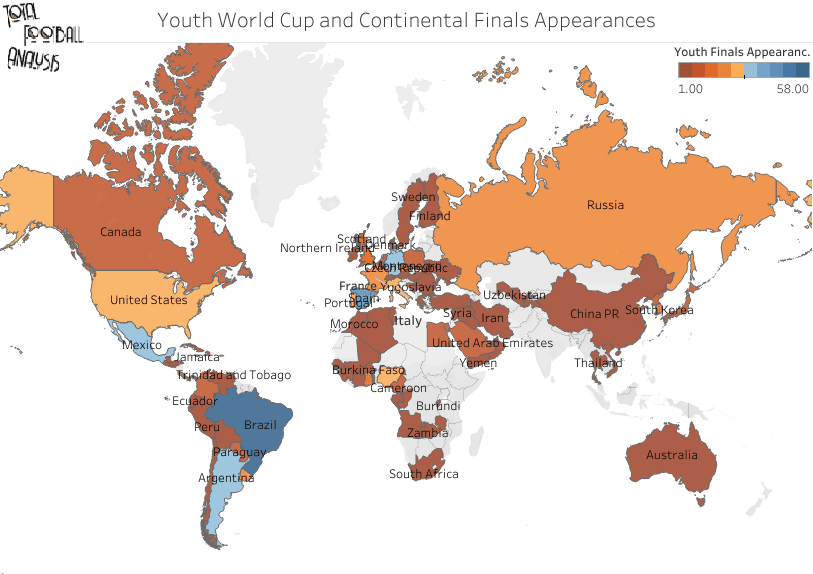
From the extraordinary 58 youth trophies of Brazil to those countries that are happy to even have one title, the map gives a nice view of both the international and regional powerhouses. Spain rates second in the list with 46 youth trophies, followed by the 35 of Argentina and Mexico, who lead Germany’s 34 trophies. Nations such as Portugal, the United States, Italy, Nigeria and England all fall into the mid-20s, a tribute to their international and regional performances.
With a better understanding of the top historic youth national team programs, we now want to see which specific teams experienced the greatest degree of success. As we move forward, note that when you see a number listed next to a country, that number indicates the birth cutoff year of the group in question. For example, Luís Figo’s “71 Portugal” represents the cutoff year, so, like Figo, the players were more than likely born in 1972.
In the visual below, we see the 10 teams that made three total final appearances at the youth level, an extremely difficult feat to achieve.
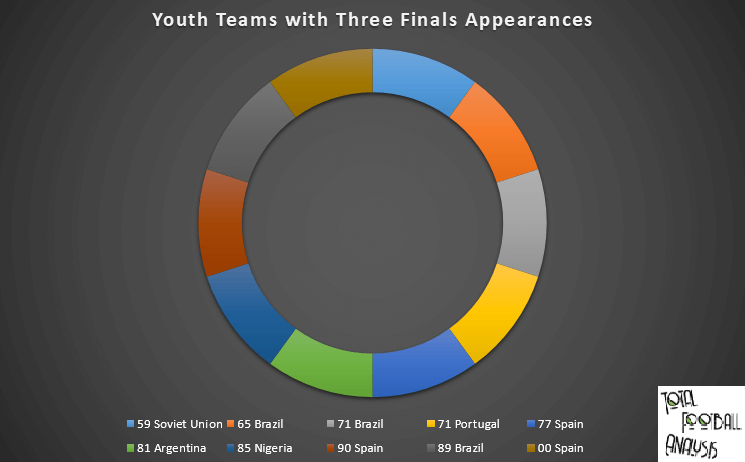
One thing that was abundantly clear when crunching the numbers is that it almost seems absurd to count Brazil in the Golden Generation study. The South Americans are ever-present in the youth World Cups and Continental, finishing with at least a semifinals appearance in most tournaments. On this list alone, three Brazilian teams pop up in the list of 10 most successful youth teams. Had I expanded the list to two finals appearances, nearly every Brazilian age group would have qualified for our shortlist. With that in mind, we’ll move forward with the understanding that Brazil is in a sphere of their own, not dependent on Golden Generations, but, rather, a perennial power with an expectation for titles. Spain and Argentina are close to joining this elite status, but we’ll limit this to Brazil for now.
Looking at the senior level contribution of these teams, only the 77 Spanish side lifted a World Cup trophy. The 90 Spain squad came just after the string of Spanish success, but they do have a continental runner-up medal to their name. That final Spanish side, the 00 squad, is one of the powerhouses to watch going forward.
Looking at the remaining nations, 81 Argentina was a World Cup runner-up, but none of the other groups placed higher than 4th (71 Portugal) at the World Cup. That said, those sides were highly successful in continental play, either winning their respective tournament or finishing as runners-up.
Since no Golden Generation is composed of a single birth year, finding supporting squads with above-average production is the next step. In fact, the most successful national teams will feature two to four regulars per birth year. Missing this component puts the status of the national team in jeopardy, much like the United States and Italy’s failure to reach the previous World Cup. Gaps in talent, especially from prime-aged players, is devastating.
Studying each country’s top youth performers, filtering for all tournament semifinalists at the youth World Cups and continental tournaments, I identified strings of highly successful youth squads. It’s these collections of successful youth teams that ticked all the boxes for Golden Generation status.
Grouping those teams and tracking their progress, we now have a list of Golden Generations. In the image below, we have the country, range of years for that Golden Generation and their best senior-level results.
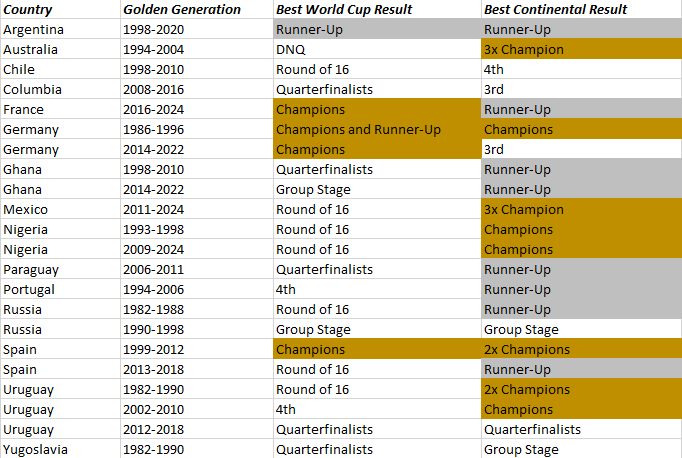
Global football’s powerhouses are well represented in the “Best World Cup Result” statistic category. Notice that it’s really only the traditional powers that secured World Cup titles from their Golden Generations. Several others came close, such as Portugal and Uruguay, but ultimately fell short.
Looking specifically at continental success, we see that this is where the second-tier nations generally come away with hardware. Nearly each of the elite Golden Generation teams earned at least silver status. Of those that didn’t make it to a final, three of the six were at least semifinalists.
Do Golden Generations produce great individual talents or vice versa?
Examine any Golden Generation and you’ll find that a significant concentration of the country’s top 20 players of all-time were key components of the success. You’ll also find generational talents, such as Luís Figo and Lionel Messi, are present. Looking at the current climate of the game, Kylian Mbappé will surely play a major role in France’s current success, especially since he’s supported by an extremely talented and deep squad, one that won the World Cup and finished second at the Euros despite refusing to call up Karim Benzema, the prolific Real Madrid forward and one of the game’s elite number nines.
That got me wondering if generational talents, the Ballon d’Or and continental award winners, were at the core of Golden Generations or if the squads, while obviously talented, relied more heavily on a stronger, more balanced squad that implemented the nation’s footballing culture.
In the image below, winners of the awards at the top of the column are listed outside of the parenthesis. Those digits in parenthesis indicated that the Golden Generation had a squad member who was on the final shortlist for the award. Each listing per column represents the total number of players to win or earn consideration for the award. For example, Messi has won six Ballon d’Or awards, but he’s the only Argentinian to do so from 1998-2020, so the nation gets a one in the stat category.
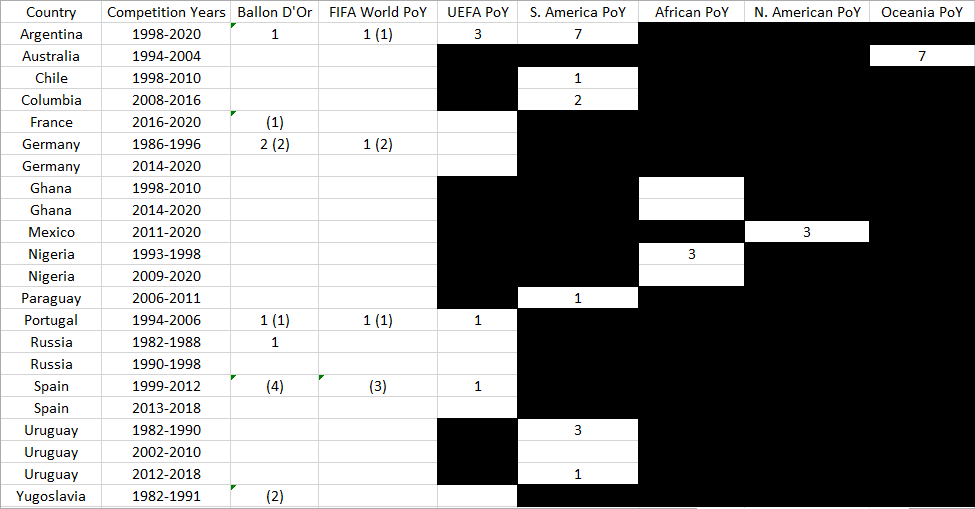
With the black boxes removing impossibilities, you get a sense of how few nations produced top global and continental talents. Germany and Spain are well represented in the Ballon d’Or and FIFA World Player of the Year voting, then there’s Luís Figo’s award-winning 2000 campaign paired with Deco’s 2004 second place season. Yugoslavia’s Dejan Savićević and Darko Pančev were on the final shortlist in 1991, giving us four nations out of 22 finishing with multiple winners or finalists for the most prestigious awards in the game.
Where the Golden Generations tend to produce the most award winners is in the continental award. Most of them have winners of the continent’s player of the year award, so, even though these players are not among top few, they are, nonetheless, top talents from the home continent.
Looking at the visual below, one thing that’s clear is that football’s elite nations, joined by the then Oceania based Australia, produce a greater share of football’s top players. These are the nations that routinely reach the semifinals of competitions and claim the bunk of the silverware.
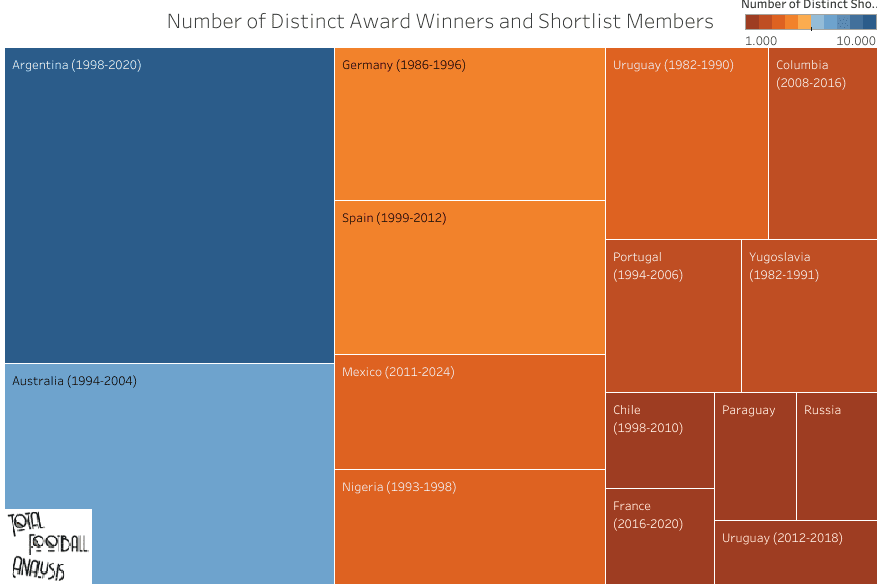
Beyond the elite nations, the regional dominance of Nigeria and Mexico is represented by the number of continental award winners in the Golden Generation. Meanwhile, in Europe and South America, the nation’s to the right side of the graphic typically boasted strong overall teams with one or two superstars.
Another thing to consider is that defenders, midfielders and goalkeepers rarely win the awards, so it’s difficult to gauge the total talent level of these sides. Portugal wouldn’t have experienced the success they did without the likes of Ricardo Carvalho and Ricardo. Take the fiery performances and leadership of Gary Medel away from Chile and that’s a radically different side.
With only seven of the 22 generations not claiming at least one global or continental award and few of the nations producing generational talents, it seems fair to say that when football’s elites produce generational talents, they’re automatically favourites to win the World Cup or continental competition. In an objective sense, trophies are the measure of success.
For the European and South American nations falling short of elite status, as well as any side from the remaining four regions, the Golden Generations can have a great deal of success, but on a relative scale. Rather than the Golden Generation winning the World Cup, it’s more likely that they’ll advance to the quarterfinals. On the continent, European and South American sides would call a semifinal or final appearance a massive success, whereas Golden Generations in the other regions would have higher regional standards.
Outside of the elite footballing nations, success is surpassing the benchmarks of previous generations, especially those markers of more recent generations. Instead of an objective, global standard, the success of these nations is relative to their own history.
Are there any Golden Generations to watch for in the coming decade?
Now, with expectations of Golden Generations covered, it’s time to gaze into the crystal ball and look for tomorrow’s top nations. With success at youth tournaments, especially success from consecutive age groups, correlating to a higher level of senior-level results, I parsed through the data to uncover the nations that will command the world’s attention.
We all know that Brazil, Spain, Argentina, Germany and France will kick on at elite status, so I’ve decided to highlight six other nations.
The first nation is Portugal. Though the Portuguese youth players have struggled in World Cups, they are always a contender for the title. In Europe, the Portuguese youth national teams have managed to win two titles, finish as runners-up twice and reach two additional semifinals.
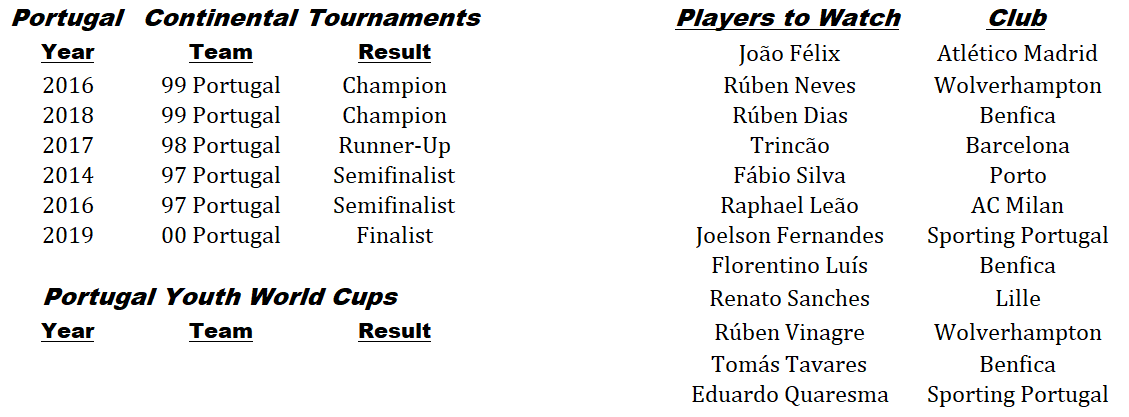
With the likes of João Félix, Rúben Neves, Rúben Dias and Trincão in the fold, this is a well-balanced squad with a few elite players, think the EPL’s Bernardo Silva and Bruno Fernandes, just a few years ahead of them, this is a group that could surpass Figo and Deco’s Portugal. Renato Sanches is regaining his form at Lille and Raphael Leão continues to impress at AC Milan, then you’ve got an impressive amount of top-level talent just entering the first team at their respective clubs.
Next is England. Though they’re a historic powerhouse with improved performances in recent years, the lack of finals appearances and trophies keep them from elite status. As strong as the David Beckham team of old was, this group of players might be even more talented. Champions at both the World Cup and Euros, these youth sides are the hope of a nation.
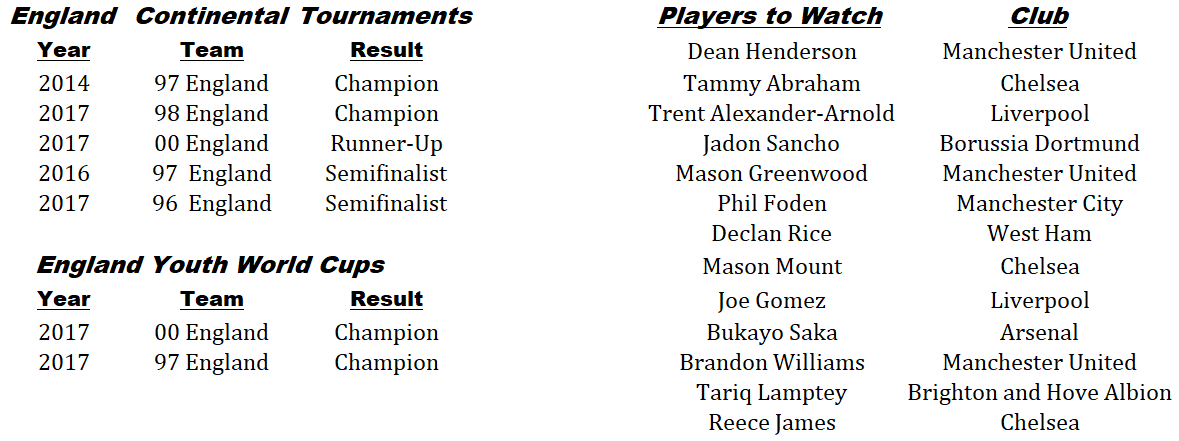
Looking at the players to watch, it’s no wonder the English dream of bringing football home. The future is bright with a wealth of leading EPL talents. Trent Alexander-Arnold receives more votes for the top right-back in the world, Jadon Sancho’s transfer fee will include nine digits and Dean Henderson is close to unseating David de Gea at Manchester United. Joe Gomez is a Champions League and EPL winner, and we’ve only covered half of the list. Watch out for this generation of players.
Hopping south of Europe, we have a Mali side that’s sure to make waves in the coming years. With three recent championships and a semifinal appearance in the Africa Cup of Nations youth tournaments, then reached three semifinals, including a runners-up appearance, at the youth World Cups.
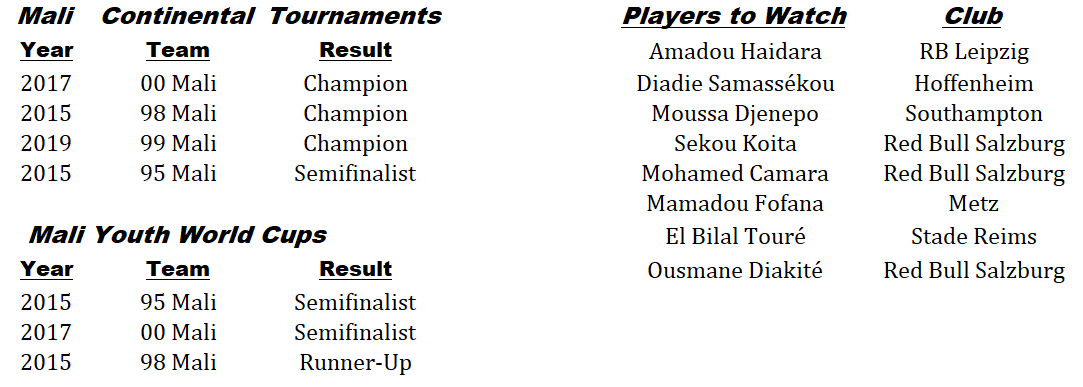
Amadou Haidara made 19 appearances for RB Leipzig and Diadie Samassékou had a successful first season with Bundesliga. Moussa Djenepo earned 18 appearances for Southampton, Mamadou Fofana is now joined by Kiki Kouyaté at Metz, a trio of Malians at Stade Reims and this side should be a regular in upcoming World Cups. Red Bull Salzburg have four young Malians on the first team roster, so there’s a lot of top-level talent coming out of the country right now.
El Tri are a perplexing case. The current Mexican senior side is widely regarded as the country’s Golden Generation, but they’ve failed to surpass the standards of their predecessors. Mexico has been knocked out of the World Cup in the Round of 16 an incredible seven consecutive times. The last time they weren’t knocked out in that round, it’s because they were banned from the 1990 World Cup in Italy. Given the strength of the current squad and the promising talent coming of age, that should change sooner rather than later.
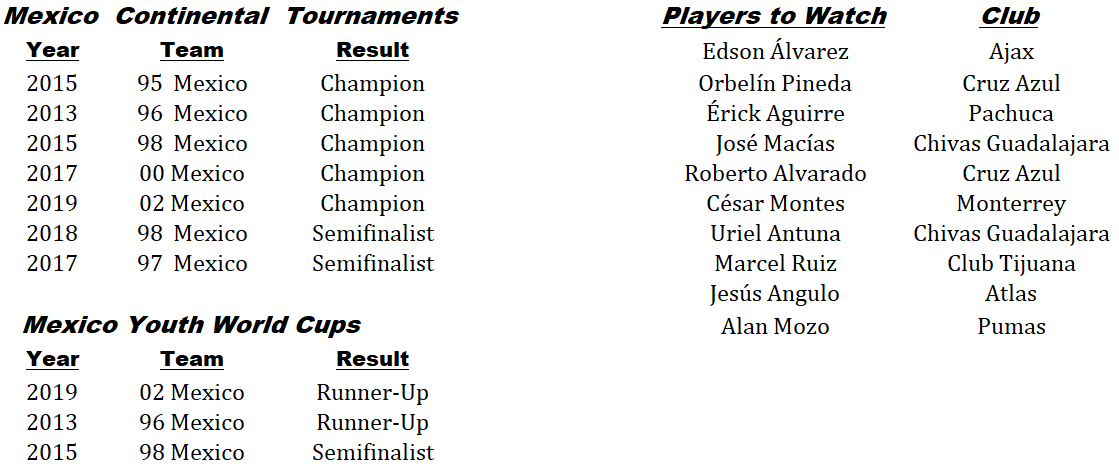
CONCACAF’s dominant side has reached the youth World Cup semifinal three times in recent years. With the exception of Ajax’s Edson Álvarez, most of the young Mexicans are still in LigaMX. It’s not uncommon for top Mexican players to spend most of their career in Mexico, so this isn’t shocking. Orbelín Pineda and Roberto Alvarado are off to great starts for Cruz Azul, Érick Aguirre is an entertaining left-back for Pachuca and Monterrey’s César Montes is the centre-back of the future.
Returning to Africa, this Nigerian generation is one to watch. With two youth World Cup titles and a continental trophy to their name, this is a well-balanced squad with top talent across the board. In addition to their championships, the youth squads have reached the semifinals in Africa four additional times in recent years, including one runner-up finish.
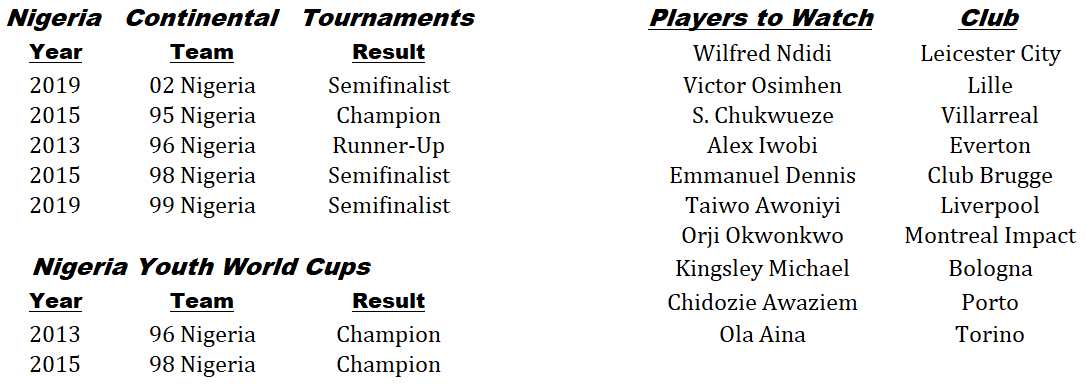
Wilfred Ndidi is the best-known player from the squad. Since transferring from Genk in 2017, he’s consistently one of Leicester City’s most important players. He’s joined in the EPL by Everton’s Alex Iwobi and Liverpool’s Taiwo Awoniyi. Up top, this Nigeria side features the scoring exploits of Victor Osimhen, who, at the time of writing, is on the verge of a big-money transfer to Napoli. With Villarreal’s Samuel Chukwueze offering a threatening presence on the wings, this is a nation that will enter upcoming World Cups with hopes of deep runs into the knockout rounds.
Finally, we have South Korea, a side closely mirroring that of Mexico. The youth teams have consistently found their way into the semifinals of the youth Asian Cups with the 97 South Koreans taking home the title. On the global stage, the 99s managed to finish as runners-up in the World Cup, showing that the regional excellence of the youth teams is prepared for the global stage.

Also like Mexico, most of the players ply their trade domestically. The exceptions are Kang-in Lee, who made 17 appearances for Valencia, Seung-ho Paik, the former Barcelona B player now on the books at Darmstadt, and In-beom Hwang, the former Vancouver Whitecaps player who’s off to a hot start with his new club, Rubin Kazan. Everyone else on the list currently plays in South Korea, but, given the level of success they’ve experienced on the international stage, this will be a prime recruiting hub for undervalued players.
Conclusion
The term “Golden Generation” can mean a number of different things. It can highlight the surprising success of the senior team, point to an unprecedented period of success or allude to a generation of players that excelled at every step in their careers, including the youth ranks. That final group was the focus of this analysis.
Statistics show that highly successful youth teams can serve as the backbone for the senior team through the players’ prime years. If that highly decorated side is flanked by age groups with a comparable level of success and talent, the nation sings the praises of their Golden Generation. The burden is heavy, but these players generally deliver new standards of success for the nation.
An elite country can, and should, expect World Cup and continental trophies, whereas each of the other nations will likely experience unmatched periods of success, eyeing the quarterfinals of the World Cup and the finals in the regional tournament. For the nations that fall just outside of elite status, like the Portugals, Netherlands, Malis and Chiles of the world, a Golden Generation represents the best hope of lifting a senior level trophy.
Beyond the trophy case, Golden Generations are a sign of hope, a chance to embrace the youthful romance with the beautiful game. Promises of brilliant football, extraordinary adventures and pride of the nation fill the hearts of the most curmudgeonly spirits. Does the side always live up to the hype? In a relative sense, yes. Will they enchant the patriot? Of course.

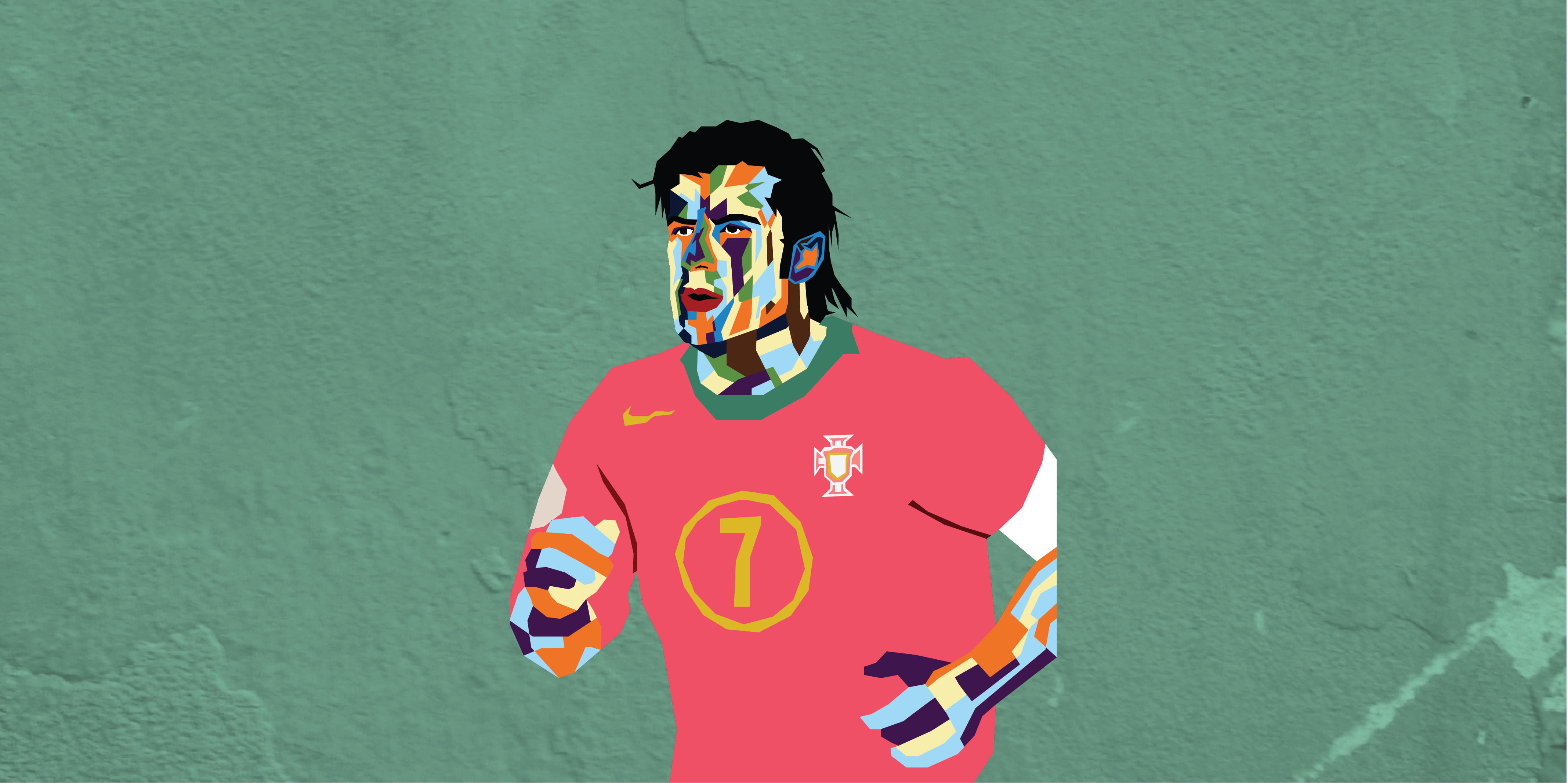



Comments